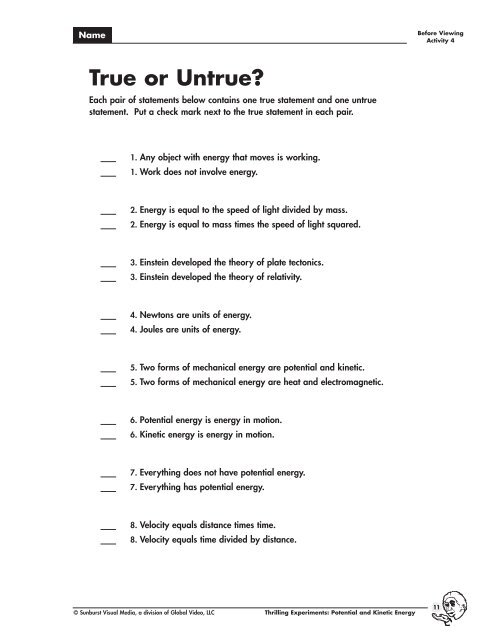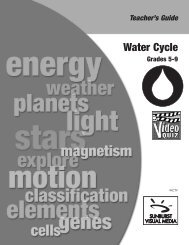Thrilling Experiments: Potential and Kinetic Energy
Thrilling Experiments: Potential and Kinetic Energy
Thrilling Experiments: Potential and Kinetic Energy
You also want an ePaper? Increase the reach of your titles
YUMPU automatically turns print PDFs into web optimized ePapers that Google loves.
Name<br />
True or Untrue?<br />
Each pair of statements below contains one true statement <strong>and</strong> one untrue<br />
statement. Put a check mark next to the true statement in each pair.<br />
1. Any object with energy that moves is working.<br />
1. Work does not involve energy.<br />
2. <strong>Energy</strong> is equal to the speed of light divided by mass.<br />
2. <strong>Energy</strong> is equal to mass times the speed of light squared.<br />
3. Einstein developed the theory of plate tectonics.<br />
3. Einstein developed the theory of relativity.<br />
4. Newtons are units of energy.<br />
4. Joules are units of energy.<br />
5. Two forms of mechanical energy are potential <strong>and</strong> kinetic.<br />
5. Two forms of mechanical energy are heat <strong>and</strong> electromagnetic.<br />
6. <strong>Potential</strong> energy is energy in motion.<br />
6. <strong>Kinetic</strong> energy is energy in motion.<br />
7. Everything does not have potential energy.<br />
7. Everything has potential energy.<br />
8. Velocity equals distance times time.<br />
8. Velocity equals time divided by distance.<br />
© Sunburst Visual Media, a division of Global Video, LLC <strong>Thrilling</strong> <strong>Experiments</strong>: <strong>Potential</strong> <strong>and</strong> <strong>Kinetic</strong> <strong>Energy</strong><br />
Before Viewing<br />
Activity 4<br />
11











